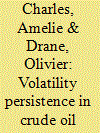|
|
|
Sort Order |
|
|
|
Items / Page
|
|
|
|
|
|
|
| Srl | Item |
| 1 |
ID:
092570


|
|
|
|
|
| Publication |
2009.
|
| Summary/Abstract |
This study examines the random walk hypothesis for the crude oil markets, using daily data over the period 1982-2008. The weak-form efficient market hypothesis for two crude oil markets (UK Brent and US West Texas Intermediate) is tested with non-parametric variance ratio tests developed by [Wright J.H., 2000. Alternative variance-ratio tests using ranks and signs. Journal of Business and Economic Statistics, 18, 1-9] and [Belaire-Franch J. and Contreras D., 2004. Ranks and signs-based multiple variance ratio tests. Working paper, Department of Economic Analysis, University of Valencia] as well as the wild-bootstrap variance ratio tests suggested by [Kim, J.H., 2006. Wild bootstrapping variance ratio tests. Economics Letters, 92, 38-43]. We find that the Brent crude oil market is weak-form efficiency while the WTI crude oil market seems to be inefficiency on the 1994-2008 sub-period, suggesting that the deregulation have not improved the efficiency on the WTI crude oil market in the sense of making returns less predictable.
|
|
|
|
|
|
|
|
|
|
|
|
|
|
|
|
| 2 |
ID:
124677


|
|
|
|
|
| Publication |
2013.
|
| Summary/Abstract |
In this paper, we study the relationship between futures and spot prices in the European carbon markets from the cost-of-carry hypothesis. The aim is to investigate the extent of efficiency market. The three main European markets (BlueNext, EEX and ECX) are analyzed during Phase II, covering the period from March 13, 2009 to January, 17, 2012. Futures contracts are found to be cointegrated with spot prices and interest rates for several maturities in the three CO2 markets. Results are similar when structural breaks are taken into account. According to individual and joint tests, the cost-of-carry model is rejected for all maturities and CO2 markets, implying that neither contract is priced according to the cost-of-carry model. The absence of the cost-of-carry relationship can be interpreted as an indicator of market inefficiency and may bring arbitrage opportunities in the CO2 market.
|
|
|
|
|
|
|
|
|
|
|
|
|
|
|
|
| 3 |
ID:
127303


|
|
|
|
|
| Publication |
2014.
|
| Summary/Abstract |
Financial market participants and policy-makers can benefit from a better understanding of how shocks can affect volatility over time. This study assesses the impact of structural changes and outliers on volatility persistence of three crude oil markets - Brent, West Texas Intermediate (WTI) and Organization of Petroleum Exporting Countries (OPEC) - between January 2, 1985 and June 17, 2011. We identify outliers using a new semi-parametric test based on conditional heteroscedasticity models. These large shocks can be associated with particular event patterns, such as the invasion of Kuwait by Iraq, the Operation Desert Storm, the Operation Desert Fox, and the Global Financial Crisis as well as OPEC announcements on production reduction or US announcements on crude inventories. We show that outliers can bias (i) the estimates of the parameters of the equation governing volatility dynamics; (ii) the regularity and non-negativity conditions of GARCH-type models (GARCH, IGARCH, FIGARCH and HYGARCH); and (iii) the detection of structural breaks in volatility, and thus the estimation of the persistence of the volatility. Therefore, taking into account the outliers on the volatility modelling process may improve the understanding of volatility in crude oil markets.
|
|
|
|
|
|
|
|
|
|
|
|
|
|
|
|
|
|
|
|
|